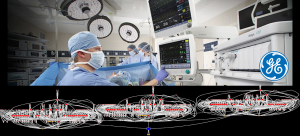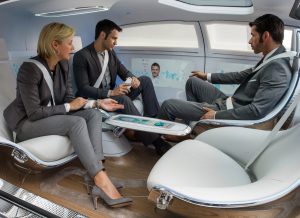The smart machine era: The rise of the robot overlords
Recently, my 14-year old son brought home a not-so-great report card. I wanted to motivate him to do better, so I asked, “What do you want to do with your life?”
He looked up at me. Then, he looked down at our dog, sleeping contentedly on the floor. He looked back at me, and said, “Dad, I want to be a pet of the robot overlords.”
I was floored. This is my legacy? This is his ambition?
Then I realized … throughout history, those who use the current technology do best. He plans to specifically use smart machines? That’s not a bad career ambition at all. Being a pet is smart. Being a good pet is brilliant.
Moore’s Law says that computers double in capability every 1.5 years. This rate shows little sign of flattening. Assuming it continues, computers in 40 years will not be 10x, 100x or even 1,000x better than today. Computers will be a mind-boggling 100,000,000x better than today. The implications could not be more profound.
Your children will not drive. Your children will not write. Your children will not compose music. Or, at least they will not have to. There are already intelligent computing systems challenging human capabilities in all these areas.

Figure 1: Disruption. Gartner said the smart machine era will be the most disruptive in history. The exponential increase in processing power and networking will profoundly impact every industry. Source: RTI
The rise in raw processing power is only half the story. Today’s other mega trend is pervasive device networking, known as the internet of things. There are already several times more devices online than there are people. Soon, there will be hundreds of billions of devices connected. Easy, fast networking is following a dramatic exponential curve.
For the next two or three decades, the most important technology drivers will be the rise of artificial intelligence and pervasive device networking. Soon, essentially everything manmade will be both smart and connected.
But, industry moves slowly. For decades, little of importance has changed. Most of today’s industry is unchanged by the internet. Medical treatment systems, the power grid, manufacturing lines and transportation systems work the same way they did 20 years ago. But in the next few years, engineers in every industry will find a way to use this change in computing. This transformation will obsolete every company that does not respond. Success depends on their ability to compete in this new reality.
The rise of powerful connected computing is not just another factor in design. It is the factor. This change will rewrite vendor relationships, redefine profitability and reimagine delivery from environment to cost to product. If you are a designer, your challenge is to look beyond today’s experience into a future, the future, dominated by intelligent computing.
Consider medical care in hospitals. Shockingly, hospital error is the third leading cause of death in the United States. Today’s devices don’t talk to each other; they don’t even know they are connected to the same patient.
This system is not good enough. Simple mistakes happen in hundreds of ways. For instance, a Harvard Medical School survey found that every surgical team made the same disastrous mistake in a heart-bypass surgery at least once: forgetting to resume ventilation after disconnecting the heart-lung machine. That error is not easy to fix, because it is only one of hundreds. Patient-controlled analgesia (PCA) is a simple system that allows thousands of patients to self-administer morphine after a surgery. PCA is widely used and considered safe, but it still kills two to three patients a day. There are simply too many failure modes for hospital staff to manage this on their own.

Figure 2: Connected medical devices. GE Healthcare, the largest manufacturer of hospital devices, is building the next generation of intelligent, connected devices. This diagram shows a test of 300 rooms with a hierarchical connection topology. The design will allow over 1,000 rooms and hundreds of thousands of devices. Source: GE Healthcare
The smart machine disruption will change that. By connecting devices together and adding “doctor in a box” smart software, most of these errors will be history. GE Healthcare, for instance, is building a system capable of handling 200,000 connected devices in a 1,200 bed hospital.
The biggest disruption however, will be driverless cars. I call them “carbots,” because they are more like robots on wheels than an evolution of cars.
Carbots are better than drivers. By eliminating the cause of 94% of accidents, carbots will purge the carnage from our roads. Carbots can drive in close formation, saving energy and time and making good use of today’s carpool lanes. They will also extend our practical travel range, clear DUIs from our courts, bestow freedom of motion on those who can’t drive, and improve nearly every aspect of daily life.

Figure 3: Carbot. Autonomous cars will forever change transportation. Carbots will increase free time, provide mobility for all and eliminate most collisions. Source: RTI
Of course, smart machines will also change jobs. Carbots, for instance, will disrupt driving, eliminate roadside hotels, revolutionize elder and child care, obsolete auto insurance and do away with auto-body shops. Driverless cars will impact our economy and society more than anything since the horseless carriage. But technology has always done that since its earliest days. Progress has nonetheless greatly improved our lives.
So, what will people do? That’s a great question, which is unanswerable. Even if you knew the answer, nobody would understand it. This is not new; if you went back in time to 1975, you could never explain why or how a service technician keeps Facebook running. The future will bring unknowable companies and jobs.
We do know one thing: The economic impact will be huge. Analysts differ on specific numbers and penetration rates, but agree on the magnitude: trillions. The smart machine era will be a multitrillion-dollar feast. Exploding economies generate many new jobs and roles.
That certainly doesn’t imply that you can ignore the disruption. We all need to embrace the robot overlords. Every company must seek a way to use the technology.
In the end, smart machines will make our world much better. Your children may not drive, write, compose music or make buying decisions, but they will live in a healthier, safer world. The smart machine era will be liberating in ways we cannot imagine today.
My advice? Simply put, find your link to things that think.
All IoT Agenda network contributors are responsible for the content and accuracy of their posts. Opinions are of the writers and do not necessarily convey the thoughts of IoT Agenda.
